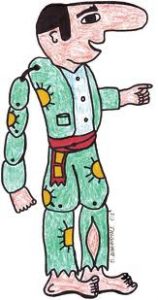Our 5th grade English coursebook presents in the form of a listening practice task the pancakes, a delicacy that is usually included in the English breakfast. Our learners, triggered by the discussion in the classroom, found information about the English breakfast and wrote articles about it. In addition, having tasted the English breakfast at school, they presented their thoughts and impressions for the English school paper! Finally, they wrote recipes for the pancakes!
English breakfast at school
by John Kalantzis (5th grade)
In February we decided to have an English breakfast at school.
Our English teacher made pancakes and she brought cornflakes and tea. My classmates and I bought milk, honey, chocolate and strawberry syrup.
When we started to eat I felt great. First, we ate cornflakes and after that we ate the pancakes. They smelled fantastic! After that, we drank a cup of tea.
That day I was excited because I think that it was fantastic and I want to do it again one day!
English breakfast at school
by Helen Alamanioti (5th grade)
English breakfast at school is very beautiful, because we eat a lot of different things for breakfast: pancakes, tea, praline, marmalade, milk with corn flakes. It’s a very good breakfast and we like it. And we said thank you, miss and you did a lot of things for us!!! THANK YOU VERY MUCH FOR EVERYTHING!!!
English breakfast at school
by Kosmas Gourgiotis (5th grade)
I liked English breakfast at school. English people have a good breakfast for children. I want to eat again English breakfast, I liked it very much. My friends liked English breakfast, too.
English breakfast at school
by Danae Xiromeriti (5th grade)
Last Wednesday we had English breakfast with our English teacher, Miss Vivi Hamilou. The children brought different things. We were all excited and impatient, because we had never eaten English breakfast before!
The food that we ate was delicious! We ate a lot! We ate pancakes that our English teacher cooked. We ate the pancakes with jam, honey and praline. The children who ate a pancake with praline could not eat another one because they had enough! We drank tea, but some children who didn’t like it drank water.
I think this breakfast was fantastic and delicious and I am going to eat it every morning!
English breakfast
by George Papargiris (5th grade)
In England people eat a very big breakfast. They eat pancakes, milk, eggs, and tea. That’s very good because people work better. Some students did a recearch on the good breakfast. Some kids ate a big breakfast and the other kids drank only milk. Then they wrote a test. The children who ate a big breakfast did very well at the test, but the children that drank only milk did not write very well.
English breakfast
by Helen Kaltsouni (5th grade)
People in England believe – and that’s right – that breakfast must be the main meal of the day, because they all need energy and strength for the rest of the day.
So, they all have a rich breakfast that has cereals with milk, eggs with bacon, sweet pancakes and they drink fresh orange juice and, of course, hot tea! People in England drink a lot of tea in the mornings and in the afternoons.
We should all do the same and we should all have a good breakfast, so we will be able to continue our day and be creative!
Pancakes
by George Papargiris (5th grade)

Ingredients:
Solid ingredients
2 cups of flour
2 tablespoons of baking powder
2 tablespoons of sugar
Some salt
Vanilla
Liquid ingredients
2 cups of buttermilk (or milk)
2 eggs
2 tablespoons of olive oil
Procedure:
Sift the flour and pour all the solid ingredients in a bowl. Then pour the liquid ingredients in a bowl and mix. Pour the solid ingredients in the mix with the liquid ingredients. Mix them and wait for 5minutes. Warm a frying pan for 5 minutes. Pour a little oil or butter in the frying pan. Pour half a cup of the dough in the frying pan. Be careful, the fire must be medium! When you see small bubbles, you must turn around the pancake. Put each cooked pancake one on top of the other and serve with praline, jam or honey!







